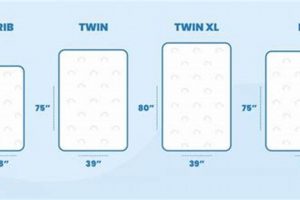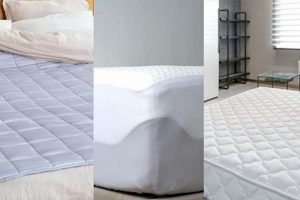The terms “medium” and “plush,” when applied to mattresses, denote distinct firmness levels that cater to differing comfort preferences and sleep needs. A medium mattress offers a balance between support and cushioning, conforming to the body’s contours without excessive sinking. Conversely, a plush mattress provides a softer, more yielding surface, emphasizing pressure relief and a cradling sensation. For example, individuals with back pain might prefer a medium mattress for spinal alignment, while side sleepers may gravitate towards a plush mattress for enhanced shoulder and hip comfort.
The selection of an appropriate mattress firmness is important because it can influence sleep quality, musculoskeletal health, and overall well-being. Historically, mattress construction focused primarily on basic support, but advancements in materials science and biomechanical understanding have led to a proliferation of firmness options. Selecting the right firmness level can improve spinal alignment, reduce pressure points, and promote restful sleep. The benefits extend beyond immediate comfort, potentially mitigating chronic pain and improving long-term posture.
This article delves into the specific characteristics of mattresses within the aforementioned firmness categories, examining their construction, suitability for various sleep positions and body types, and potential advantages and disadvantages. The discussion will also address how individual preferences and physical considerations play a key role in determining the optimal choice for achieving a comfortable and restorative sleep experience.
Considerations for Choosing Between Medium and Plush Mattress Firmness
Selecting between medium and plush mattress options necessitates a thorough evaluation of individual sleep preferences and physiological needs to ensure optimal sleep quality and postural support.
Tip 1: Assess Body Weight and Sleep Position: Individuals with higher body weights generally benefit from a medium mattress, which provides adequate support and prevents excessive sinking. Side sleepers may find relief on a plush surface due to its ability to contour and alleviate pressure on the shoulders and hips. Back sleepers might lean towards a medium mattress to maintain proper spinal alignment.
Tip 2: Evaluate Spinal Alignment: Proper spinal alignment is crucial for preventing back pain and promoting restful sleep. A medium mattress typically offers a better balance of support and contouring for many individuals, promoting neutral spinal posture.
Tip 3: Consider Pressure Point Relief: Plush mattresses excel at relieving pressure points, particularly in the shoulders, hips, and knees. Individuals experiencing joint pain or arthritis may find greater comfort on a plush surface.
Tip 4: Account for Partner Preferences: If sharing a bed, consider a mattress that accommodates the preferences of both sleepers. A medium-firmness hybrid design might be a suitable compromise, offering a balance of support and comfort.
Tip 5: Factor in Mattress Construction: The materials used in mattress construction affect firmness. Memory foam tends to conform more closely than innerspring coils. Hybrid mattresses combine both materials to balance support and contouring.
Tip 6: Test Before Purchase: Whenever possible, test the mattress in a store, spending at least 10-15 minutes lying in various sleep positions to gauge its comfort and support.
Tip 7: Review Warranty and Return Policies: Ensure the mattress comes with a sufficient warranty and a reasonable return policy, allowing ample time to assess its suitability at home.
Choosing the appropriate mattress firmness is an investment in sleep health and well-being. Careful consideration of personal needs and preferences is essential for selecting a mattress that promotes restful sleep and long-term comfort. The subsequent sections will delve deeper into related factors influencing the overall sleep experience.
1. Supportive spinal alignment
Supportive spinal alignment is fundamentally linked to mattress firmness, specifically the differentiation between medium and plush options. The mattress’s ability to maintain the natural curvature of the spine during sleep is a critical factor in preventing back pain and promoting musculoskeletal health. A mattress that is either too firm or too soft can disrupt this alignment, leading to discomfort and potential long-term issues. For instance, a plush mattress, while offering initial comfort, may lack adequate support, causing the spine to sag and resulting in lower back pain. Conversely, a medium mattress aims to provide a balanced surface, conforming to the body’s contours while preventing excessive sinkage, thereby promoting proper spinal alignment. The cause and effect are evident: improper mattress firmness leads to poor spinal alignment, which can manifest as pain, stiffness, and reduced sleep quality.
The importance of supportive spinal alignment as a component of mattress selection is exemplified in the context of different sleeping positions. Side sleepers, for example, require a mattress that allows the shoulder and hip to sink in slightly, maintaining the spine’s lateral alignment. A medium-firm mattress may be suitable for some, while others may require a plusher surface with targeted support zones. Stomach sleepers generally benefit from a firmer surface to prevent excessive arching of the back. Real-life examples abound; individuals with pre-existing spinal conditions, such as scoliosis or herniated discs, often require specifically tailored mattress firmness to mitigate pain and promote restful sleep. The selection of a medium or plush mattress, therefore, becomes a critical element in managing these conditions.
In summary, the connection between supportive spinal alignment and mattress firmness hinges on the mattress’s ability to maintain the spine’s natural curvature. Selecting an inappropriate firmness level can lead to misalignment and associated health issues. The practical significance of understanding this connection lies in the ability to make informed decisions about mattress selection, tailoring the choice to individual needs and preferences to promote optimal sleep quality and musculoskeletal health. Challenges remain in accurately assessing individual needs, highlighting the importance of trying out different mattresses and seeking professional advice when necessary, ensuring the selection supports long-term spinal well-being.
2. Pressure Point Relief
Pressure point relief, an important consideration in mattress selection, directly relates to the firmness level specifically, the difference between medium and plush options. The degree to which a mattress alleviates concentrated pressure on areas such as the shoulders, hips, and knees significantly impacts sleep quality and comfort.
- Surface Conformity and Pressure Redistribution
Plush mattresses are generally designed with a greater capacity for surface conformity. This means the mattress yields to the body’s contours, distributing weight across a wider area and reducing pressure concentration at specific points. For example, a side sleeper on a plush mattress experiences less direct pressure on the shoulder and hip compared to a firmer surface, potentially alleviating discomfort and preventing pressure sores. In contrast, medium mattresses provide a degree of conformity while maintaining support, resulting in a more balanced pressure distribution.
- Material Composition and Responsiveness
The material composition of a mattress significantly influences its pressure-relieving capabilities. Memory foam, often incorporated into plush mattresses, is known for its viscoelastic properties, allowing it to mold to the body’s shape and reduce pressure points. Latex, another common material, offers a more responsive and buoyant feel, providing pressure relief without excessive sinking. Medium mattresses may utilize a combination of materials to balance pressure relief with support. Innerspring mattresses, typically firmer, may incorporate comfort layers to mitigate pressure points.
- Individual Sensitivities and Medical Conditions
Individual sensitivities and pre-existing medical conditions often dictate the need for specific pressure point relief. Individuals with arthritis, fibromyalgia, or other conditions characterized by chronic pain may benefit from a plush mattress that minimizes pressure on sensitive joints. Conversely, individuals with back pain may require the support of a medium mattress to maintain spinal alignment while still providing some pressure relief. Therefore, assessing individual needs and consulting with a healthcare professional are crucial steps in selecting the appropriate mattress firmness.
- Long-Term Comfort and Support Degradation
While plush mattresses may initially offer superior pressure point relief, the long-term durability and support degradation must be considered. Over time, plush mattresses may lose their ability to effectively distribute weight, leading to increased pressure points and discomfort. Medium mattresses, with their greater density and support, may maintain their pressure-relieving capabilities for a longer period. Regularly rotating and flipping the mattress can help to prolong its lifespan and maintain consistent pressure relief.
In summary, the selection between a medium and plush mattress for optimal pressure point relief hinges on a multifaceted evaluation encompassing surface conformity, material composition, individual sensitivities, and long-term durability. Both firmness levels offer distinct advantages and disadvantages, necessitating a personalized approach to mattress selection that prioritizes individual needs and preferences.
3. Body weight accommodation
Body weight accommodation constitutes a primary determinant when choosing between a medium or plush mattress, directly influencing spinal alignment, pressure distribution, and overall sleep quality. The causal relationship is straightforward: higher body weights necessitate greater support to prevent excessive sinking, maintaining a neutral spinal position. A plush mattress, characterized by its softer surface, may compress excessively under significant weight, leading to spinal misalignment and potential discomfort. In contrast, a medium mattress typically provides a firmer foundation, distributing weight more effectively and minimizing sinkage, thereby promoting proper spinal alignment. The importance of appropriate body weight accommodation cannot be overstated; failure to select a mattress with sufficient support can exacerbate existing musculoskeletal issues and impede restorative sleep. Real-life examples include individuals with obesity reporting back pain aggravation on excessively soft mattresses, while those of average weight may find the same mattress comfortable. The practical significance of understanding this connection lies in the ability to make informed purchasing decisions that prioritize spinal health and long-term comfort.
The impact of body weight accommodation extends beyond simple support; it also influences pressure point relief. A plush mattress, while initially conforming to body contours, may bottom out under higher weights, resulting in concentrated pressure on bony prominences. Conversely, a medium mattress offers a balance between support and contouring, distributing weight more evenly and mitigating pressure points. Athletes, for instance, often require mattresses that can accommodate their higher muscle mass and weight while providing adequate pressure relief for joints stressed during training. Selecting a mattress that effectively accommodates body weight can improve sleep quality, reduce pain, and promote muscle recovery. Furthermore, the materials used in mattress construction, such as high-density foams or reinforced coil systems, play a crucial role in enhancing weight-bearing capacity and durability.
In summary, the link between body weight accommodation and mattress firmness is inextricably tied to spinal alignment, pressure distribution, and overall sleep quality. Selecting an inappropriate mattress firmness can lead to discomfort, pain, and compromised sleep. While individual preferences play a role, understanding the fundamental relationship between body weight and mattress support is essential for making informed decisions. Challenges remain in accurately predicting individual needs based solely on weight, highlighting the importance of considering body composition, sleeping position, and any pre-existing health conditions. Proper body weight accommodation is a critical component in achieving a comfortable and restorative sleep experience.
4. Sleep position suitability
Sleep position suitability is a key factor in determining the optimal mattress firmness, particularly when differentiating between medium and plush options. The alignment of the spine, pressure point distribution, and overall comfort are significantly influenced by the interaction between sleeping posture and mattress surface.
- Side Sleeping and Contouring Support
Side sleeping necessitates a mattress that allows the shoulder and hip to sink in sufficiently to maintain spinal alignment. A plush mattress, characterized by its yielding surface, typically offers greater contouring and pressure relief for these areas. However, excessive sinking can lead to spinal curvature and discomfort. A medium mattress, conversely, provides a balance between contouring and support, preventing excessive sinkage while accommodating the natural curves of the body. The suitability of either firmness depends on individual body weight and shoulder width; those with broader shoulders may require a plusher surface to prevent shoulder impingement.
- Back Sleeping and Spinal Alignment
Back sleeping demands a mattress that supports the natural curvature of the spine, preventing both excessive arching and flattening. A medium mattress generally offers the appropriate level of support for back sleepers, distributing weight evenly and maintaining spinal alignment. A plush mattress may lack sufficient support for the lumbar region, leading to spinal strain and discomfort. However, individuals with lower body weights may find a plush surface provides adequate support without compromising spinal alignment.
- Stomach Sleeping and Firm Support
Stomach sleeping is generally discouraged due to its tendency to promote spinal misalignment. However, those who habitually sleep in this position typically require a firmer mattress to prevent excessive arching of the back. A medium mattress may provide adequate support for some stomach sleepers, while a plush mattress is generally unsuitable due to its potential to exacerbate spinal misalignment. Employing a thin pillow or placing a pillow under the hips can help mitigate spinal strain for stomach sleepers.
- Combination Sleeping and Adaptable Support
Individuals who shift between multiple sleeping positions throughout the night require a mattress that adapts to varying support needs. A medium mattress offers a compromise between contouring and support, accommodating different sleeping positions without compromising spinal alignment. A plush mattress may be less suitable for combination sleepers due to its lack of consistent support across different positions. Hybrid mattresses, which combine different materials and support zones, can offer a more adaptable sleep surface for combination sleepers.
In summary, sleep position suitability is a crucial determinant in selecting between a medium and plush mattress. Side sleepers typically benefit from the contouring support of a plush surface, while back sleepers generally require the balanced support of a medium mattress. Stomach sleeping necessitates a firmer surface to prevent spinal misalignment. Combination sleepers require a mattress that adapts to varying support needs. The optimal choice depends on individual preferences, body weight, and sleeping habits.
5. Material construction variance
Material construction variance serves as a foundational determinant of mattress firmness, directly influencing whether a mattress is categorized as medium or plush. The specific materials used, their arrangement, and their inherent properties dictate the degree of support, contouring, and pressure relief a mattress provides. Therefore, understanding material composition is crucial in differentiating and selecting between medium and plush mattresses.
- Core Support Systems
The core support system, typically comprised of innerspring coils or foam layers, forms the structural foundation of a mattress. Innerspring coils provide varying degrees of firmness based on their gauge (thickness) and coil density. Higher-gauge coils offer greater support, generally found in medium-firm mattresses. Foam cores, conversely, vary in density and composition, with high-density foams offering firmer support and low-density foams providing a softer, plusher feel. Hybrid mattresses combine both coil and foam systems to achieve a specific balance of support and contouring.
- Comfort Layers
Comfort layers, positioned atop the core support system, directly influence the initial feel of the mattress. Materials such as memory foam, latex, and fiberfill contribute to varying degrees of plushness. Memory foam conforms closely to the body, providing enhanced pressure relief and a sinking sensation, typically associated with plush mattresses. Latex offers a more responsive and buoyant feel, providing pressure relief without excessive sinking. Fiberfill, often used in quilting layers, adds a layer of softness and cushioning. The thickness and density of these comfort layers significantly impact the overall firmness and feel of the mattress.
- Cover Materials
The cover material, while not directly influencing support, contributes to the overall feel and breathability of the mattress. Tightly woven covers tend to create a firmer surface feel, while loosely woven or quilted covers offer a softer, plusher sensation. Materials such as cotton, wool, and synthetic blends are commonly used, each offering different levels of breathability, moisture-wicking properties, and surface texture. The cover material can also influence heat retention and overall sleep comfort.
- Zoning and Layering Techniques
Zoning and layering techniques further enhance the ability to fine-tune mattress firmness and support. Zoned mattresses incorporate varying levels of support across different areas, such as firmer support in the lumbar region and softer support in the shoulder region. Layering different materials with varying densities and properties allows manufacturers to create specific combinations of support, contouring, and pressure relief. These techniques enable the creation of mattresses that cater to specific sleep positions and body types, blurring the lines between traditional medium and plush categories.
In conclusion, material construction variance is a critical factor in differentiating between medium and plush mattresses. The core support system, comfort layers, cover material, and zoning techniques all contribute to the overall feel and performance of the mattress. Understanding the properties of these materials and their arrangement is essential for making informed purchasing decisions and selecting a mattress that meets individual sleep needs and preferences. Variations in these elements allows manufacturers to tailor the sleeping experience for individual needs.
Frequently Asked Questions
This section addresses common inquiries and misconceptions regarding the selection of mattress firmness, specifically focusing on the distinction between medium and plush options. The information provided aims to offer clarity and guidance for individuals seeking to make informed decisions about their mattress purchase.
Question 1: What defines a “medium” versus a “plush” mattress?
A medium mattress provides a balance between support and cushioning, conforming to the body without excessive sinking. A plush mattress offers a softer, more yielding surface, emphasizing pressure relief and a cradling sensation. The difference lies in the degree of surface give and the overall level of support provided.
Question 2: Is one firmness inherently better than the other?
Neither firmness is inherently superior. The optimal choice depends entirely on individual sleep preferences, body weight, sleeping position, and any existing health conditions. A mattress that is comfortable and supportive for one individual may be unsuitable for another.
Question 3: How does body weight influence the choice between a medium or plush mattress?
Individuals with higher body weights typically require the greater support of a medium mattress to prevent excessive sinking and maintain spinal alignment. Lighter individuals may find a plush mattress provides adequate support without compromising comfort.
Question 4: Are certain sleeping positions better suited to specific mattress firmness levels?
Yes. Side sleepers often benefit from the contouring support of a plush mattress to relieve pressure on the shoulders and hips. Back sleepers generally require the balanced support of a medium mattress to maintain spinal alignment. Stomach sleepers typically need a firmer surface to prevent excessive arching of the back.
Question 5: Do material compositions play a role in determining mattress firmness?
Indeed. Memory foam tends to conform closely to the body, often associated with plush mattresses. Latex offers a more responsive feel. Innerspring coils provide varying degrees of support, influencing overall firmness. The specific combination and density of these materials dictate the mattress’s firmness level.
Question 6: How important is it to test a mattress before purchasing?
Testing a mattress before purchase is highly recommended. Spending time lying on different firmness levels in various sleeping positions allows individuals to gauge comfort and support. This firsthand experience is invaluable in determining the optimal choice.
In summary, selecting between a medium and plush mattress involves careful consideration of individual needs and preferences. There is no universally “best” firmness, and the optimal choice depends on a multitude of factors. Testing and gathering information are essential steps in making an informed decision.
The subsequent sections will explore techniques to maintain and prolong the lifespan of either mattress type, ensuring that the selected sleeping experience remains comfortable and supportive for years to come.
Conclusion
The preceding exploration of the medium vs plush mattress spectrum underscores the nuanced considerations involved in optimizing sleep quality. Key factors include spinal alignment, pressure point relief, body weight accommodation, sleeping position, and the impact of varied material construction. Each of these elements contributes uniquely to the overall sleep experience, demanding careful assessment to facilitate informed purchasing decisions.
The selection of an appropriate mattress firmness is not merely a matter of preference, but an investment in long-term health and well-being. Continued research and advancements in sleep technology promise further refinements in mattress design, offering increasingly personalized solutions for a diverse range of needs. Therefore, diligent evaluation and informed choices remain paramount in navigating the complexities of mattress selection, ultimately contributing to enhanced sleep quality and improved overall health outcomes.


![Leesa vs Casper Mattress: Which Bed is Best [2024]? Organic & Natural Mattress Buyer’s Guide: Non-Toxic Sleep Solutions Leesa vs Casper Mattress: Which Bed is Best [2024]? | Organic & Natural Mattress Buyer’s Guide: Non-Toxic Sleep Solutions](https://mattressworldpa.com/wp-content/uploads/2025/07/th-1078-300x200.jpg)




